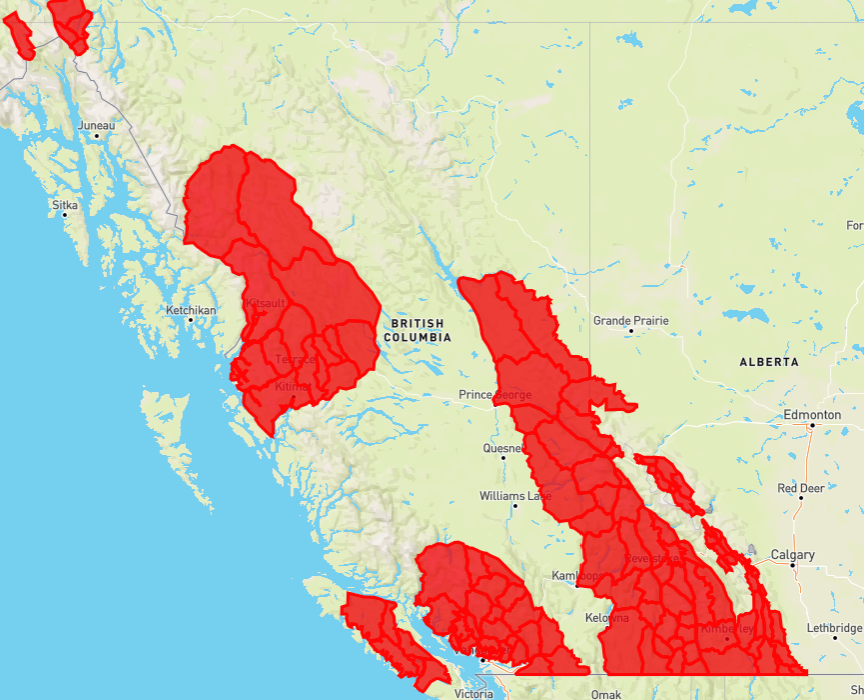BANFF – A special avalanche warning has been issued for much of western Canada, including the mountain parks of Banff, Yoho and Kootenay national parks and neighbouring Kananaskis Country.
Environment Canada is forecasting temperatures in the Bow Valley and K-Country to reach 21 degrees Celsius by Saturday (April 29), followed by 24 C throughout Sunday, Monday and Tuesday, before the mercury soars to 26 C on Wednesday – with temperature records in jeopardy of being smashed.
This special warning from Avalanche Canada is in effect immediately until the end of Monday, May 1 over a large-scale region in British Columbia and Alberta, where there have been 14 avalanche fatalities so far this winter.
Experts with Avalanche Canada say the sudden and dramatic transition from cool, wintry conditions in the alpine to these warmer temperatures is expected to destabilize the snowpack, resulting in “dangerous, destructive avalanches”.
These avalanches will likely be very large and may run to valley bottoms, they say.
“Dangerous avalanche conditions exist for all mountainous regions in western Canada and the hazard increases with each day of warm air,” said Mike Conlan, a senior avalanche forecaster with Avalanche Canada in a news release.
“Regions with persistent or deep persistent slab avalanche problems will be especially problematic, with avalanches potentially involving the full depth of the snowpack,” he added.
“Warming can also initiate large and destructive cornice falls. Cornices can be destructive by themselves but also act as a trigger for destructive deep persistent avalanches.”
Justin Shelley, a meteorologist with Environment and Climate Change Canada, said starting Thursday (April 27) and ramping up into the weekend, an upper ridge building over the western parts of the continent will push warm air from the south into the Alberta region.
“We're going to see those temperatures likely in the low to mid 20s throughout all of next week, and it might even get a touch warmer than that,” said Shelley.
There is potential that several temperature records for this region of the Bow Valley and K-Country will be broken over the next week.
The average daytime temperature for Banff at this time of year, according to Environment Canada, is about 12 or 13 C.
“For this time of year, we’re going to see temperatures potentially double that starting this weekend and through next week,” said Shelley.
Weather data from Banff shows the record for April 29 is 25 C set in 1926; 23.3 C is the record for April 30 set in 1957; 23.9 C for May 1 set in 1889; 25 C for May 2 also set in 1889; and 23.7 C for May 3 set more recently in 2016.
“There’s a couple that are definitely in jeopardy,” said Shelley.
“We’re definitely going to be in record territory for for the daily records, but I always like to give the disclaimer that daily records aren't always necessarily representative to look at a longer time period.”
In this region, the avalanche warning level reaches high in the alpine and at and below treeline on Friday, meaning travel in avalanche terrain is not recommended as natural avalanches are “likely” and human-triggered slides are “very likely.”
So far this winter, 14 people have lost their lives to avalanches in B.C. – many of whom were extremely experienced – and a 15th person was killed while skiing out-of-bounds at the Lake Louise ski area in Alberta on April 22.
The death toll is well above the 10-year average.
In that latest incident, a 21-year-old from Red Deer was in a group of three when he, and one of his companions was swept away in an avalanche. While he died on scene despite extensive efforts to resuscitate him, his friend was partially buried and rescued by Lake Louise ski patrol.
The deceased was identified as Cale Stecyk, who played with the Junior B Rocky Rams hockey team.
That avalanche, triggered by the skiers in West Louise Bowl and ran 200 metres wide and 550 metres long, was classified as a size 3.
Avalanches are classified by destructive potential.
A size 3 avalanche could bury and destroy a car, damage a truck, destroy a small building, or break a few trees, while size 4 could destroy a railway car, large truck, several buildings, or a forest area up to four hectares.
Backcountry users should always check the avalanche forecast at www.avalanche.ca. Everyone in a backcountry party needs the essential rescue gear – transceiver, probe, and shovel – and the training to use it.
"All backcountry users, including hikers and scramblers, and anyone recreating in avalanche terrain are advised to leave a wide margin for error during this warming period, stick to simple, low angle terrain, and avoid all overhead avalanche hazards," states the warning by Avalanche Canada.




